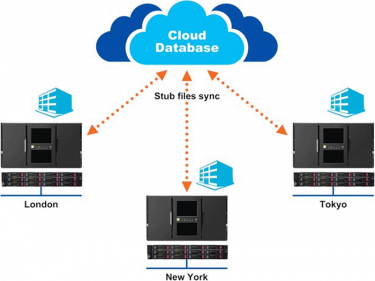| Українська | English | |||||||||||
|
|||||||||||
| News | About company | Service-centre | OB Van/SNG Rental | NextGen Energy Solutions | Contact us |
|
|
Engineering Service, Inc.
» News News Data storage solution provider has launched an object storage S3 interface for its entire range of on-premise active archives that provide long-term secure storage on LTO data tape cartridges. The launch transforms the XenData archive systems into private cloud data repositories that compete with public cloud storage services such as AWS Glacier and the Archive Tier of Azure object storage. The S3 interface is enabled by a simple software upgrade.
Dr Phil Storey, XenData CEO, explained that “our new private cloud solutions keep the attractive aspects of LTO on-premises archives which include cost effective scalability and adds the ease of distributed access which has traditionally been associated with public cloud storage.” For active archives with capacities above 100 TB, storage systems based on LTO data tape libraries have an attractive total cost of ownership that is significantly lower than public cloud object storage, XenData reported. An S3 enabled XenData LTO archive provides restore times of around 2 minutes which is suitable for most infrequently accessed data repositories. And when compared to AWS Glacier or Azure Archive Tier object storage, the XenData private cloud solution provides higher performance at a lower cost, free of any egress charges, the company reported. The new S3 interface allows remote access to a XenData LTO archive from anywhere worldwide using secure HTTPS. It also supports replication of one LTO archive to a second LTO system at another location which can even be on a different continent. In addition to the S3 interface, XenData launches Global Sync, a synchronization service that links multiple S3 enabled LTO archives, creating a single global file system accessible anywhere worldwide. As soon as a file is archived to LTO at one location, it becomes available as a stub file within the global file system. When a user makes a change by writing, overwriting or deleting a file, that change is propagated to all locations. This provides a consistent up-to-date set of files across the entire distributed organization. When files are restored from another location, they are transferred directly using peer to peer multi-threaded HTTPS which delivers secure fast file transfers. The Global Sync service uses a cloud database, but the files themselves are never stored in public cloud object storage, avoiding cloud storage and egress fees. Furthermore, because the new service only synchronizes file system metadata, it requires minimal Internet bandwidth, XenData reported. « To the list of news |
|
|||||||||||||||||
 |
+38 (044) 593-18-20 +38 (073) 593-18-20 +38 (096) 532-96-82 +38 (095) 532-96-82 Service center Telegram @Engineer_Service |

|
|
|||||
 |
e-mail: engineer-service.tv 15 Vavylovykh str., Kiev, 04060, Ukraine Authorized service centre of Panasonic, Sony, JVC, Fujinon, Canon |
|||||||







